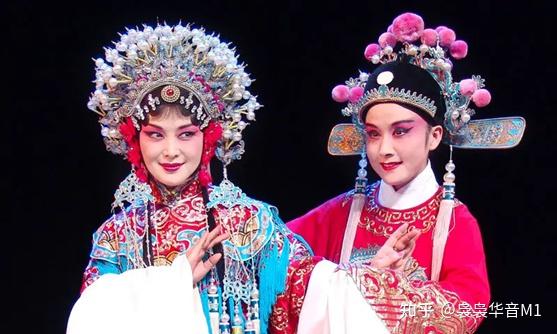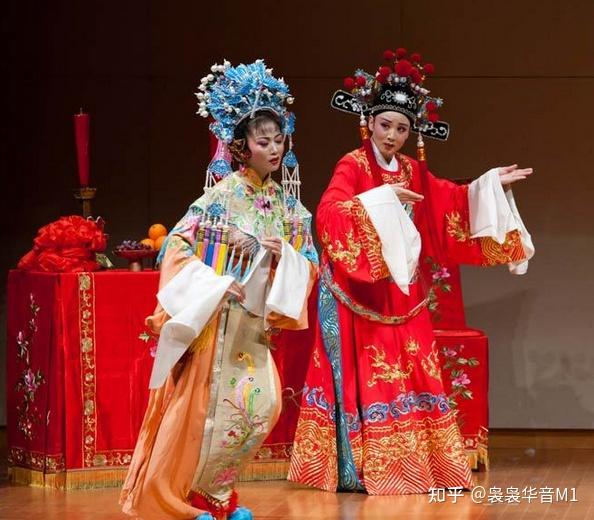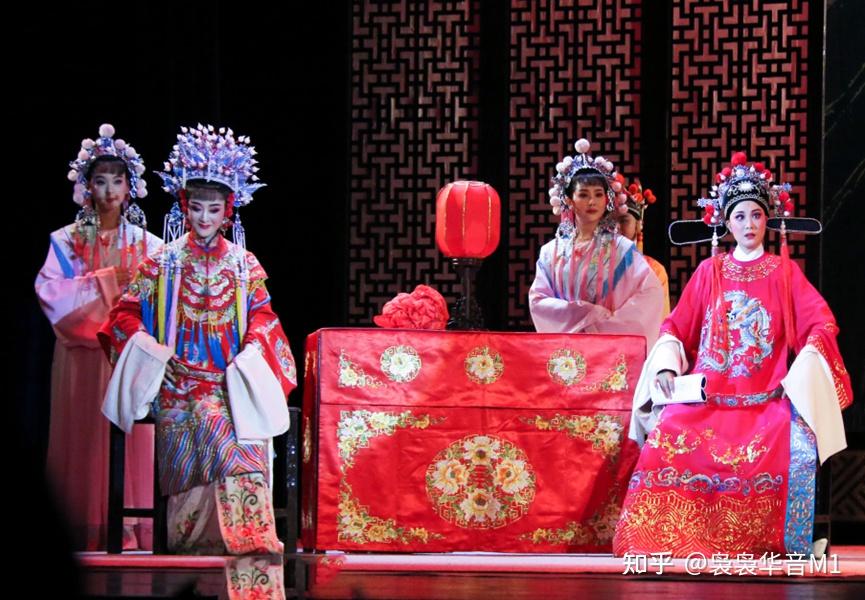|
|
近年来流行歌曲融入戏曲元素成为一大卖点。一首《赤伶》火遍全网,慕容晓晓的《黄梅戏》更是将黄梅戏这一五大戏曲之一再度带入了人们的视野 。今天我们就一起来了解一下黄梅戏 。

(图片转载于网络)
为救李郎离家园
To save Li Zhaoting, I left my home
谁料皇榜中状元
Who would have thought I’ll score as a top scholar
中状元着红袍
As a top scholar, I wear the red gown
帽插宫花好啊好新鲜
Flowers of honor on my hat, a very fresh experience for me
我也曾赴过琼林宴
I have already visited the banquet in the Jade Forest
我也曾打马御街前
Paraded on horseback on the Emperor’s street
人人夸我潘安貌
Everyone praises me for my good looks
——《女驸马》
(Emperor’s Female Son-in-Law (Nv fuma))
黄梅戏,也称黄梅调或采茶戏,中国五大戏曲剧种之一。唱腔淳朴流畅,以明快抒情见长,具有丰富的表现力。以高胡为主要伴奏乐器,加以其它民族乐器和锣鼓配合,适合于表现多种题材的剧目。Huangmei Opera, originally known as Huangmei melody or tea-picking Opera, is one of the five most noted Chinese traditional operas. It features simple and mellifluent lucid and lively lyrics and rich expressiveness. With Gaohu as the main accompaniment instrument and other Chinese traditional musical instruments such as gongs and drums, it is suitable for diverse themes.

(图片转载于网络)
起源
黄梅戏起源于湖北东部黄梅县。一说明代末年张献忠的农民起义军在湖北战败后,流散在湖北黄梅一带的军中“乐人”以演唱谋生。后来他们演唱的歌舞在黄梅县境内演变成戏曲形式,即为黄梅调。Huangmei Opera originated in Huangmei County in eastern Hubei Province. It is said that after when Zhang Xianzhong's peasant rebel army was defeated in Hubei in the late Ming Dynasty, the minstrels in the army scattered around Huangmei in Hubei Province and made a living by singing. Later, their songs and dances evolved into operas in Huangmei County, known as the Huangmei tune.

(图片转载于网络)
另一说黄梅戏源于黄梅县的采茶调。清代乾隆年间,该县逃水荒的灾民来到安庆地区之后,将黄梅采茶调与当地民间艺术相结合,形成了这种戏曲形式。黄梅戏老艺人丁永泉就说过:“黄梅调是逃荒的人用渔鼓筒子唱过来的。”
There is another saying that Huangmei opera originated from tea-picking tunes in Huangmei country. During the reign of Qianlong in the Qing Dynasty, the victims of the deluge in this county came to the Anqing area and combined the tea-picking tunes of Huangmei with the local folk art to form Huangmei opera. Ding Yongquan, an old artist of Huangmei Opera, once said, "Huangmei melody was sung by people fleeing the famine with fishing drums."
发展
关于其历史沿革,学界普遍认为黄梅戏的起源最早可追溯到唐代。据史料记载,早于唐代时期,黄梅采茶歌就很盛行,经宋代民歌的发展、元代杂剧的影响,逐渐形成民间戏曲雏形。至明清,黄梅县戏风更盛。Regarding its historical evolution, it is generally believed that the origin of Huangmei opera can be traced back to the Tang Dynasty. According to historical records, as early as the Tang Dynasty, the tea-picking song of Huangmei was very popular. With the development of folk songs in the Song Dynasty and the influence of Yuan poetic drama, the prototype of folk opera was gradually formed. During the Ming and Qing dynasties, the opera of Huangmei County became more popular.

(图片转载于网络)
18世纪时,黄梅戏在安徽省、湖北省和江西省十分流行。从辛亥革命到中华人民共和国成立的这段时间里,黄梅戏的表演逐渐专业化,并从农村地区走向到城市舞台。在黄梅戏传播到安庆之后,艺人们进一步发展了戏曲,并借鉴了其他戏曲的表演风格。他们改造了传统歌谣,减少了虚词,使得这种戏曲通俗易懂,节奏明快。
The Huangmei opera was active in Anhui Province, Hubei Province, and Jiangxi Province in the 18th century. From the Revolution of 1911 to 1949, Huangmei performances gradually became professional, from rural areas to city stages. After Huangmei arrived in Anqing City, artists developed the opera and borrowed performance styles from other operas. They reformed the traditional chants, reducing the function of words to make the drama easy to understand with a lively rhythm.

(图片转载于网络)
1952年对于黄梅戏来说是至关重要的一年。正是在这一年,优秀的艺术家严凤英、王少芳等人在上海的一个大型戏曲节上进行了黄梅戏演出,引来无数惊叹和欣赏。黄梅戏以其新的歌唱形式和故事情节深深吸引了来自四面八方的观众,从此脍炙人口,名声大噪。
1952 is a key year for Huangmei opera. It was during this year that the excellent artists Yan Fengying, Wang Shaofang, and others gave performances in Shanghai for a big opera festival. Audiences from various areas were shocked and appreciated Huangmei opera, attracted by its new singing forms and stories. Huangmei opera became very popular and famous after that.
(未完待续... 欢迎关注“袅袅华音”公众号,一起了解更多的中华文化!) |
|